As we enter our fifth week of Youth Science Lessons, we begin, as always, with a lesson on invasive species. Today’s lesson is about an invasive plant you may or may not have in your yard. If you live in the northern portion of Escambia or Santa Rosa counties, your chances of finding this plant are greater. If you live in other parts of Florida, Alabama, Georgia, or Mississippi – your chances are pretty good. If you do not live the lower southeastern United States, you probably will not find this one – and that is a good thing, but we can discuss searching for others.
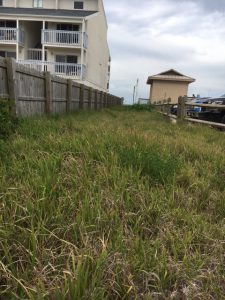
Photo: Rick O’Connor
The invasive plant I am talking about is called cogongrass. The reason I selected this one is because (a) it is a bad one, and you need to know if you have it, (b) it is in bloom right now in our part of the Florida panhandle, and it should be easier to find if you do.
It is a bad one. Once you have it, it is very difficult to get rid of – but you can get rid of it. Remember, to be consider invasive by UF IFAS, it has to have the “big three”.
#1 – Is it non-native? Yes, it is from Southeast Asia
#2 – Was it brought here by humans? Again yes, it first appeared in the early 20th century near Mobile AL. It was entangled on a shipping pallet and was released accidentally. Soon afterwards landowners from both Florida and Mississippi planted it as a cover forage crop. So, we did it – it did not come here on its own.
#3 – Is it causing an environmental and/or economic problem? Again yes – STRIKE THREE, it has small serrated edges on their long leaves which are imbedded with silica (like silvers of glass). Livestock and wildlife do not care to eat it. If a pasture becomes overgrown with this grass, you basically have wasted land. It also grows thick meadows within our timberland. When landowners are ready to harvest, the cogongrass has shown to be problematic in getting equipment in and out while cutting. Also, when burning timberland as a management tool – which is needed – cogongrass burns hot, and the fire becomes hotter than it should. These hot fires can actually kill the trees instead of improving the landscape and cost the landowners a LOT of money. So, yes – this grass is a problem.
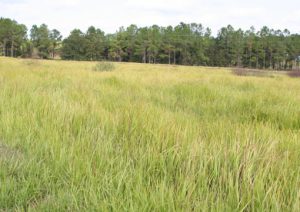
Photo: UF IFAS
It is such a nasty plant that it became a Florida noxious weed very early, is now considered a federal noxious weed, and is on the Florida prohibited list. Some consider it one of the most invasive plants on our list. Guess we should find out if you have it. LET’S HOPE YOU DON’T, but for our activity today we should take a look.
So, what does it look like?
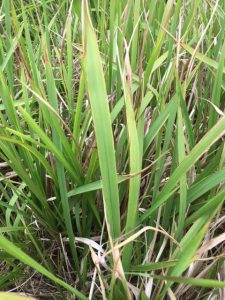
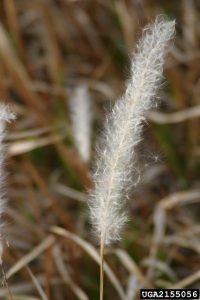
Photo: University of Georgia
Well… it is a grass, a tall grass.
– Most stands are about 2-3 feet tall, but it has been reported at six feet.
– The grass blades are a lighter shade of green than most field grasses, sort of a yellow-green, and this makes it stand out a bit in the field.
– If you look at the grass blade, there is a midrib line that is whiteish colored and it is offset from center.
– It does not appear to have a stem; the grass blade seems to grow right from the ground.
– The flower/seed head is a puffball like structure at the top of the plant. Its is cylinder shape and resembles the dandelion seeds. They are fluffy and are dispersed by the wind. BUT DO NOT BLOW THESE LIKE YOU WOULD WITH A DANDELION – this will disperse them around the neighborhood, and we do not want that. 😊 Again, they are blooming now, and this might make it easier to find.
– If you can dig beneath the plant, you will find the “runners”. These are actually horizontal stems called rhizomes. These rhizomes will be in segments and covered with a flaky scales.
– Another funny thing about this grass – it sometimes grows in a circular pattern. If you could fly a drone over your field, you would see the plant forming circles. It is harder to see this from the ground, but you might be able to notice it.

Photo: University of Georgia
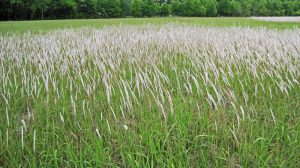
Photo: UF IFAS
So, what do I do if I find it?
In Lesson 1, which you can find at our website – https://blogs.ifas.ufl.edu/escambiaco/category/natural-resources/, you will find how to report the plant
Let’s do that first.

Photo: Rick O’Connor
Second, would be removing it. This can be tough. If you decide you want to do this, email me and we can discuss a plan.
If you do have it in your yard – we recommend that you DO NOT mow it while the flower/seeds are out – you will just spread, it. Also, if you do mow it (once the flower/seeds are gone) be sure to wash your lawn mower before you use it on someone else’s yard. We think this is how it is spreading around the area, mowing crews are mowing, loading their equipment without washing, and going to the next site. Granted, it is hard to wash the equipment before you move on but – that is spreading it.
So, let’s explore your yard this morning and see if you have it. – HOPE YOU DON’T!
ACITIVITY
– Easy enough, walk around your yard and look for a tall, yellow-green grass, possibly with dandelion-like puff balls on top – though they will be more long-cylinder shaped rather than round like the dandelion.
– If you do not, maybe it is in your neighborhood somewhere. It is often found along side a road, at the edge of a field, and in a more open pine tree area.
– If you live outside the range of this plant, look anyway – you never know 😊. But if not, maybe there is another invasive plant your parents are aware of you can look for.
– If found, consider reporting it (no matter what invasive plant you have) – and consider removing it. If you need advice, let me know.
HAVE FUN AND STAY SAFE!
 0
0
